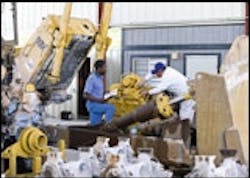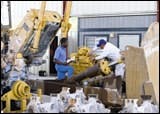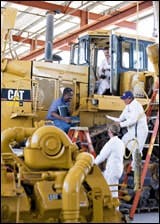In-House Training Boosts Uptime
Headquarters: Chandler, Ariz.
Specialty: Heavy-equipment rentals
Fleet Value: More than $50 million
Fleet Makeup: More than 350 units; heavy earthmoving equipment such as scrapers, motor graders, articulated dump trucks and hydraulic excavators
Facilities: Chandler, Ariz.; Escondido, Calif.; and Las Vegas
Equipment Support Staff: 50 technicians and supervisors
Market Range: Southern California, Arizona and Nevada
Red Mountain Machinery has watched the pool of qualified technicians steadily dry up, leaving behind a severe shortage that is quickly becoming a major problem.
With a fleet of more than 350 units valued in excess of $50 million, the Chandler, Ariz.-based rental firm provides heavy earthmoving equipment such as articulated dump trucks, hydraulic excavators, scrapers, graders and other machines to end-users throughout Southern California, Arizona and Nevada. In addition to Chandler, Red Mountain operates out of facilities in Escondido, Calif., and Las Vegas.
Red Mountain cannot afford to risk the health of its machines by using unskilled wrench-turners. And that was the underlying reason why company executives decided to invest $250,000 a year to create and operate a technical training department and throw the doors open to customers, vendors and even competitors, in addition to its own employees.
That was four years ago, says Jay Dee Sale, the company's director of parts and service. "I think the primary factor was the lack of trained technicians. We can hire a technician who hasn't had all the training in our specific lines of equipment, or hire even an apprentice, and give them both on-the-job and classroom training," says Sale.
Another reason the company entered the technician-training business, he says, is to attract the type of employee who wants to learn. "If you're the type of mechanic who thinks he already knows everything, then there's no incentive to come to work here," Sale says. "But if you're the type of mechanic who sees there are machines coming out and wants to stay on the cutting edge of knowledge, then this is a good place to work."
Although training was initially available to more than just Red Mountain employees, that no longer is the case, says owner Owen Cowling. "We had little success with it," he says. "We had a problem with people not showing up. Technicians were always out in the field repairing things and couldn't attend the classes."
Now Red Mountain has hired two new instructors and is focusing on its own employees only, says Cowling. Between the two trainers — Will Young and Kent Kraayenbrink — they are able to keep technicians up to date on such work as engine repairs, transmissions and electronics. "Basically, every part of the machine is covered in one class or another," says Sale.
No one ever graduates, Sale points out, since it is not a course that you go through. "It is continual training," he says. "All our employees go through training for eight hours once a month. That's done at all three facilities."
The sessions include both classroom and hands-on training with employees spending part of the time in class and part of the eight hours in the shop. Class sizes are no more than eight or nine persons, says Sale.
"We have to break up the technicians, so we actually do the same class two days in a row with half the mechanics attending one day and the other half attending the next. That's because we can't shut down the whole operation to do a class," Sale says.
Much of the curriculum is created by Red Mountain, Sale points out, with some material coming from various OEMs. "The OEMs have different training literature for their specific type machine," says Sale. "In addition to troubleshooting, we also teach failure analysis working with the software of various OEMs."
The training has made a difference at Red Mountain. With improved technician knowledge and efficiency, downtime has decreased, although it's hard to put a percentage number on it, says Sale. Technicians are also completing work faster and better, he says.
"There are two things we track. We call them 'first-day fall downs' and 'first-week fall downs,'" Sale says. "Before we started the training we weren't doing that, so it's hard to compare, but I can give you one example, and that is 'first-day' statistics. Last year, we had 0.03 percent first-day fall downs. That means that out of 1,000 days, we were down three days. That's 99 percent equipment availability."
Another area of improvement that's directly linked to training is the retention of technicians. "Although we don't track it by percentages, we know that our turnover rates have been greatly reduced at all three facilities," Sale says. Red Mountain has 40 technicians, a service manager and an assistant service manager at each location, plus parts-department people.
Realizing that a single company and its training department cannot solve the industry's technician shortage alone, Cowling has already taken steps to confront the issue on a much broader scale.
"We have our trainers working with local community colleges, such as Palomar Community College in San Marcus, Calif., to develop a program for construction-equipment technicians. There are quite a few diesel-technology schools out there, but emphasis has always been on things like engine rebuilding," he says. What's also needed, he points out, is training for field and shop technicians whose work isn't always rebuilding engines.
Cowling is convinced that establishing such technician training in conjunction with community colleges is an objective the private sector — OEMs, companies, contractors and other segments — can achieve. "The funding won't come from federal agencies," he says. "The construction industry itself has to help these colleges raise the necessary funds."
As for Red Mountain, says Cowling, "we have locations in three states and we want to establish programs in each state to get funding for training construction technicians." Because the demand for technicians is growing and technicians are becoming fewer, a career as a technician can lead to a profitable, bright future for anyone willing to learn, he says.
"When someone asks me what we pay mechanics, I always answer, 'more than we did last month,'" Cowling says.



